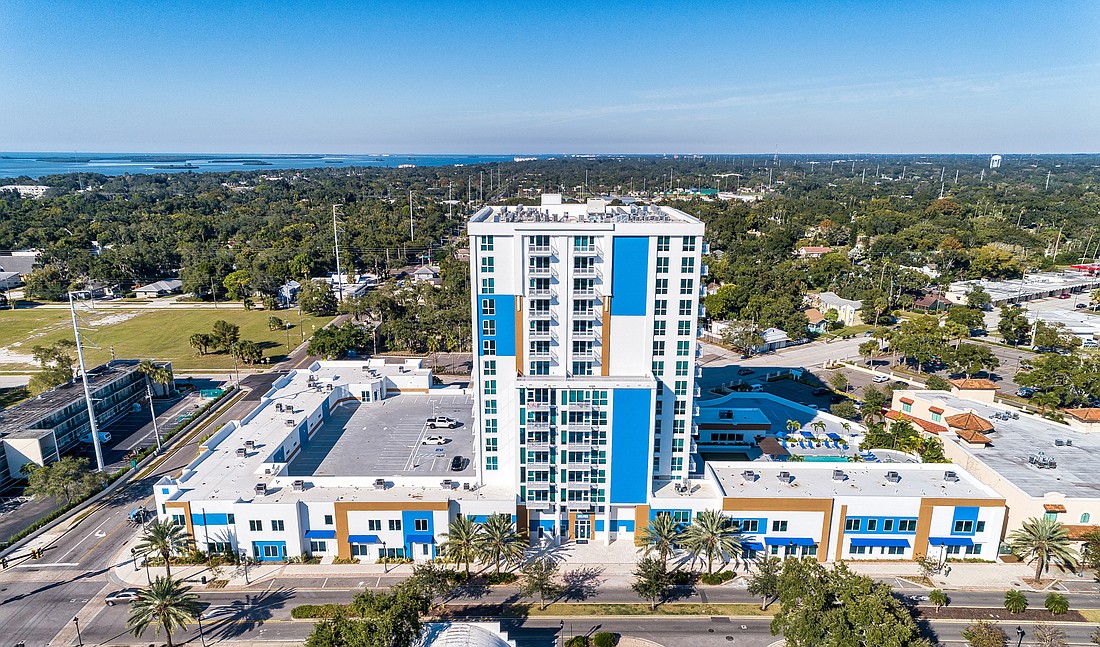- January 11, 2025
-
-
Loading

Loading

Walking up 15 stories can take some time. That’s why McShane Construction Co., when working on a recent transformation of a 15-story former office building in Clearwater into luxury apartments, had a strategy to make it more efficient.
“Just the simple travel time of walking up 15 flights of stairs can take you 15 minutes going up and 15 minutes going down,” says McShane Construction Co. Senior Project Manager Derek Lewis. “In the grand scheme of a day, you can lose an hour just traveling between floors.”
To save time, finish trades started on the top floor and went down, with materials flowing the same way. “As you’re bringing trash out of the building, you’re jumping things down to the floor below,” he says. “Once you’re done on the floor, there’s not a reason to go back. It makes things run a lot more smoothly if you can keep from backtracking.”
That sense of efficiency was top of mind for McShane as it led construction work on the project, dubbed 1100 Apex. The project by GSP Development involved converting a tower built as an office building in 1972 into apartments. The project wasn’t without its challenges, including finding enough workers to get the job done.
McShane, based in Rosemont, Ill., has satellite offices, including one in Auburn, Ala., that handles the majority of the company’s Southeastern work. McShane got involved with the project in late 2017 before construction started in early 2018. The firm was tasked with finding some savings in construction. “We tried to do as much due diligence as possible,” says Lewis. “We found a few items where we could save.”
McShane provided a value-engineering log with options to the developer. Cost savings pitched included buying prefabricated granite countertops from overseas instead of cutting them on site and using alternatives to high-end porcelain tile. The company, in a statement, says savings amounted to over $2.6 million.
Lewis, who declines to disclose the cost of the project, says savings also come from using a tower that’s already in place versus building a 15-story structure from the ground up.
In 2005 and 2006, before the economic downtown, another company tried to revamp the building. Lewis says it gutted the structure and built a two-story parking garage before the project ground to a halt.
“The first thing we had to do when we showed up was make sure everything was safe,” says Lewis. The site had become a safe haven for homeless people living in the garage and tower. McShane made sure a no-trespassing order and guardrails were in place before starting work.
“When we got involved, it was pretty much a concrete shell,” he says. The building, exposed to the elements from about 2006 to 2018, had taken a beating and needed some concrete reinforcing.
“One big thing that we struggled with was the building code,” says Lewis. Since the tower was constructed in the 1970s, the building code had changed a lot. McShane worked with fire and building departments to determine what had to be done.
‘It didn’t seem there was enough skilled labor to take care of it. Keeping guys on the job on a daily basis was a very difficult task.’ — Derek Lewis, McShane Construction Co.
The project’s architect, Tampa-based Kimmich Smith Architecture, reconfigured floor plans for residential use, working around columns placed sporadically throughout each floor. McShane added exterior walls, window systems, unit walls and corridor walls.
There were six superintendents on the project plus Lewis as senior project manager. With a project the scale of 1100 Apex, scores of other workers were needed, too. Staffing for those needs proved to be another challenge.
With many in-progress developments in the area, competition for workers was fierce. “It didn’t seem there was enough skilled labor to take care of it,” says Lewis. “Keeping guys on the job on a daily basis was a very difficult task.”
Projects down the street would offer workers a raise of 10 to 15 cents an hour, and they’d leave the McShane project and take that job. The hardest workers to find were in waterproofing, painting and framing along with drywall hanging and finishing. “Tampa is hot,” says Lewis. “There’s so much going on there, it makes sense.”
To solve the problem, McShane sought help from its subcontractors. “What we ended up doing was relying on relationships with local contractors,” he says. Workers were pulled from other jobs in Florida and elsewhere in the Southeast. “You can get into a bidding war with labor, and it will just keep going and going. Luckily, we did have those relationships in the region that were able to help.”
The now-complete project has 134 units, with 111 in the tower and 23 in surrounding townhomes. There’s also a 201-space parking garage and two ground-floor retail spaces.
Lewis says he expects to see more projects like 1100 Apex in coming years. With more urban development and limited land, prime property that’s sitting around could become more attractive. Plus, with the pandemic leading some companies to abandon office space, more office buildings could become ripe for residential redevelopment. He says, “We’re seeing a shift out of the office climate, and I think there’s going to be a lot more of this adaptive reuse.”